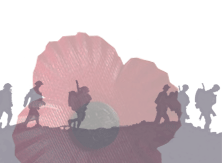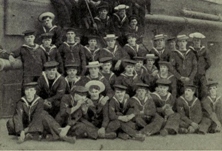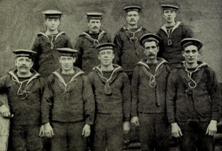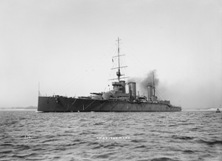William McGilp
Their names will be remembered for evermoreTwenty survivors from HMS Queen Mary were left with a horrifying image as the ship sank. As her bow plunged, the propellers were still turning, high in the air. Moments later she was gone, taking 1,266 men, among them, William McGilp. The battle cruiser was destroyed during the Battle of Jutland on 31 May, 1916. The British and Germans had each been planning a campaign to disable the other's naval power in the North Sea. In May alone, 64 British, Allied and neutral ships were lost, as the UK's naval supremacy was challenged. Assistant Paymaster McGilp, of the Royal Naval Reserve, was working as a bank clerk when he was commissioned in October 1915. Originally from Tarbert, Argyll, he had left a farming background to seek work, like his brothers. McGilp was working for the Clydesdale Bank in West George Street, Glasgow, when he received his commission. Battle Rages at Sea The Germans had been planning to lure out the British Grand Fleet, based at Scapa Flow, off Orkney. On 30 May, HMS Queen Mary left Rosyth on the east coast with the rest of Vice-Admiral Beatty's 1st Battle Cruiser Squadron to rendezvous with the Scapa Flow contingent off Norway. The next day, they engaged with the enemy off the Danish coast, and the opening salvoes were fired at 2.30pm. At about 4.30pm a salvo crashed on to the Queen Mary's forward deck. Her ammunition stores were hit, exploding and tearing the ship apart. Witnesses saw her bow plunge, lifting the stern out of the water. There was a shower of debris, followed by a pillar of smoke rising hundreds of feet. Only 20 of the crew were rescued. She went down in minutes, her propellers still turning. The site, discovered in 1991, is now a war grave. The battle of Jutland was the only major naval battle of the war. It cost Britain 14 ships, and 6,094 men. Germany lost 11 ships, and 2,551 men. In the days after the battle, groups gathered on Glasgow's streets awaiting the latest news. One junior officer wrote: "I was never quite sure what was going on and had the greatest difficulty distinguishing enemy ships from our own." Eerie Calm The Scotsman newspaper reported the eerie effect of battle on the waters: "Calm at the beginning, it soon looked as if it were under the influence of a gale, so great was the turmoil caused by the ploughing of the ships." Artillery bursting in the water destroyed shoals of fish, the report continued, and "cod, by the thousands, floated listlessly". Eerier still must have been the atmosphere of a YMCA hall in Rosyth, the stage still with its decorations for a revue show called The Busy Bee, which the crew of the Queen Mary had been rehearsing. By the day the performance was to have been given, the ship had sunk, but none of the theatre staff had the stomach to take down the set. William's father, a farm manager, was paid just over £54 for the loss of his 24-year-old son's personal effects on the Queen Mary. Equivalent to about £2,500 today, it was acknowledgment, however scant, of another life lost to the war. William is commemorated on the family grave at Tarbert, the Clydesdale Bank's memorial in St Vincent Place, and on the Portsmouth Naval Memorial. View original referenced text here: |
Images:
|















